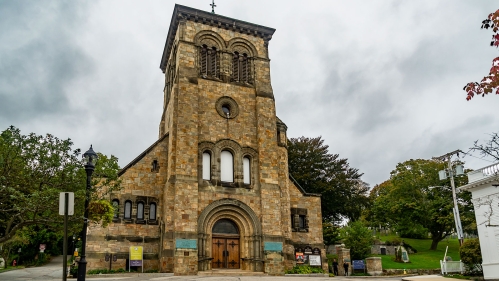Saved But Enslaved: Exploring Black and Indigenous Roots in Plymouth’s First Church

English professor’s two-year grant will help trace the spiritual lives of enslaved church congregants
In 1620, in the seaside town of Plymouth, Massachusetts, the Pilgrims founded what is today known as the First Parish Church of Plymouth. A grant-funded Rutgers University–Camden study is unveiling the untold history of Black and Indigenous membership in Plymouth’s first church through the accounts of two enslaved, married congregants.

Keith Green, associate professor of English and director of the Rutgers–Camden Africana Studies program, secured a Rutgers University Academic Affairs Research Council Grant for his project “Saved but Enslaved: Briton Hammon, Hannah Hovey, and the Earliest Black and Indigenous Members of Plymouth’s First Church, 1708-1783.” The two-year project will contribute to scholarship that shows slavery was indeed present in colonial New England. Through estate and church records, Green will also produce an unprecedented recording of Black and Indigenous membership in the Pilgrims’ founding American church.
“The church was a symbol of religious independence. It was about starting what became the American dream. It showed you could have your own faith and traditions,” Green said. “The story here is that people of color were building those traditions as well.”
Green has long studied Hammon, an enslaved Black sailor believed to have written the first slave narrative in 1760. The professor’s research pivoted when he discovered Hammon’s marriage to Hannah Hovey and her longstanding connection to the church.
Hovey joined the First Church of Plymouth in 1748 amid the Great Awakening, a period of religious revivals in the 18th century. “Women and people of color were flocking to churches in numbers that they weren't before. And Hannah Hovey is definitely a part of that generation of people of color who were coming into congregational churches in the colonial era,” Green said. “She represents the experiences of many people of color during this period in finding a relationship to faith.”
Green and Rutgers–Camden research assistants from across undergraduate and graduate English and history programs have collected data for the project through Plymouth Church Records, a detailed written history of the church from its inception until deep into the 19th century. By tracing the church’s record of events, Green and his team could confirm its worshippers included enslaved individuals.
The researchers have also combed through probate documents, which allocate an estate upon a person’s death, from the church’s white parishioners, in what Green explained as a kind of “reverse engineering.”
Slaveholders left detailed accounts of the enslaved as possessions in their estate inventories, from which Green and researchers have extracted data. “We've been using the probate documents to corroborate what we're seeing in the church minutes, but also, hopefully, to expand our sense of what their lives might have been,” Green said.
The research team hopes to uncover more about the community of faith in which Hammon, Hovey, and other enslaved congregants worshipped. Green explained that in the 18th century, Black and Indigenous slaves had been shipped to America from the Caribbean or West Africa with their own unique and complex traditions of spirituality. At the First Church of Christ of Plymouth, they would have sat in “Negro pews,” either in the back or balcony of the church, and received Communion last. “We want to learn more about the nature of their religious experiences, what it felt like for them to be in the church, and their understanding of faith,” Green said.
What the team has uncovered since the project launched last fall has confirmed details about Hammon and Hovey that propel Green’s research forward. One question the team had when they first started the project was whether Hammon and Hovey were the only people of color to be married in Plymouth’s first church. Their research has uncovered that they were not.
“They had children and formed families. I think that's a beautiful story to tell: Despite systems of oppression, people found each other,” Green said.


